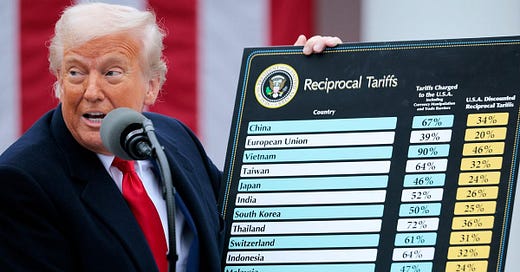The Experts Have Some Explaining to Do
Why the April Data Shattered the Consensus—and What It Means Going Forward
For weeks now, the American public has been lectured—by economists, central bankers, and media elites—about what was supposedly coming next: fiscal ruin, inflation spirals, trade war fallout, a broken supply chain, and maybe even a dollar collapse. They had charts, models, think-tank white papers, and op-eds that all said the same thing: Brace for impact.
Well, April 2025 arrived. And the impact was real—but it hit the experts.
A Surplus They Didn’t See Coming
The U.S. Treasury recorded a $258.4 billion surplus last month—the second-largest in American history. It wasn’t a statistical mirage or a COVID-recovery anomaly. It was a full-spectrum fiscal surprise: tax receipts surged to $850 billion, tariff revenue hit a record $15.6 billion, and borrowing needs dropped $53 billion below projections.
This wasn’t supposed to happen. We were told tariffs were inflationary, economically reckless. That trade would choke, consumers would revolt, and deficits would balloon. But trade didn’t choke. Consumers didn’t revolt. And the deficit? In April, it vanished.
A Market Signal Washington Can't Ignore
At the same time, the Producer Price Index collapsed—unexpectedly and decisively. The PPI fell 0.5% month-over-month, the largest drop since the early COVID shock. Core PPI, which excludes volatile food and energy prices, dropped 0.4%.
But the real story wasn’t just in the numbers—it was in the composition. Services, not goods, led the decline. This wasn’t a fluke or some base effect. This was margin compression across the economy—real, broad-based disinflation.
In other words: producer costs aren’t spiraling. They’re falling. That alone should force a reset of the narrative. But it gets worse—for the forecasters, that is.
CPI: The Phantom Inflation
Consumer inflation remains “sticky,” we’re told. But look closer. Core services account for nearly the entire CPI print, and most of that is housing-related—rents and “owners’ equivalent rent,” a fiction that lags real-world prices by 6 to 12 months.
Private market data says rents are flat or falling. But the BLS lags behind, feeding the Fed stale data. That means we’re raising interest rates to fight yesterday’s inflation—phantom inflation—while the real-time economy is already cooling off.
Sentiment Is Shifting. Quietly.
It hasn’t made the front pages, but something changed in April: for the first time since mid-2021, more Americans say their finances are improving than say they’re getting worse. A net-positive sentiment reading isn’t just a number—it’s a warning to the political class that their narrative is no longer aligned with lived reality.
This doesn’t mean the middle class is thriving. But it means the doomsday forecasts aren’t connecting. And they’re not being forgiven.
The Forecasts Were Wrong. Period.
Let’s remember what the consensus told us:
Tariffs would raise inflation.
GDP would slow.
Sentiment would tank.
Deficits would spiral.
Instead?
Tariff revenue is surging.
Inflation is cooling—fast.
Sentiment is recovering.
The U.S. posted a near-record surplus.
This isn’t some niche data fluke. It’s a broad contradiction of expert orthodoxy.
The Fed’s Problem
So what now? The Federal Reserve faces a credibility dilemma. If it continues to posture for more hikes while producer prices collapse, shelter data lags reality, and consumer sentiment turns upward, it risks looking not just cautious—but disconnected.
There is no honor in fighting the last war. And there is no justification for tightening into surplus and disinflation. Unless, of course, the goal is to preserve the image of control—rather than respond to the facts on the ground.
Final Word: What Happens When the Narrative Breaks
This isn’t about whether April’s numbers were good or bad. It’s about how wrong the experts were—and how little accountability they face when they’re wrong.
The American economy didn’t collapse under tariffs. It didn’t explode in inflation. And the government didn’t drown in red ink last month. The models failed. The consensus cracked. And the experts? They shrugged, moved the goalposts, and changed the subject.
But the public doesn’t forget. Nor should they. Because when the people who claim to know everything get everything wrong, they owe the country something rare in their circles: An explanation.





Excellent take. I chalk the miss up to TDS driven obtuseness, propaganda, and low economic IQ.